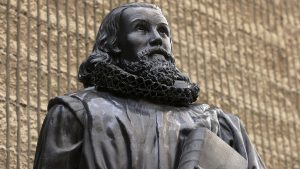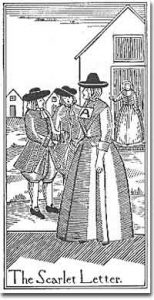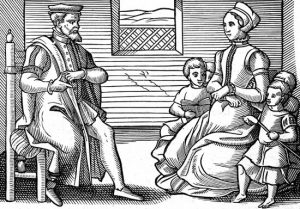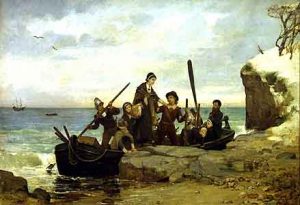As Thanksgiving draws near, I’ve been thinking about the Pilgrims and Puritans who traversed the Atlantic Ocean with the hope of practicing their religion without the fear of persecution. For the longest time I didn’t realize that these two groups while similar, were different. The Pilgrims were Puritans, or at least a distinct group of Puritans.
Let me see if I can make any sense of it for you.
The Puritans, also known as Dissenters, were Protestants who followed the teachings of John Calvin, a reformed preacher who was greatly influenced by the ministry of Martin Luther. They believed the Church of England should be purified of the ceremony, liturgy and practices that weren’t mentioned in Scripture and they rejected the ecclesiastical offices of Cardinal, Bishop, Archbishop, and Priest, but they did embrace church offices mentioned in the Bible–pastors, deacons, elders and teachers. The Bible was their sole authority in all areas of life and worship.
Some common beliefs of the Puritans:
- Predestination: The Puritans believed that before the foundation of the world, God had determined who would be saved and who would be damned. There was nothing an individual could do during their life that could change that outcome.
- Prayer: They rejected the Catholic and Anglican Book of Common Prayer, believing that prayer should be spontaneous and not scripted. They also believed that you could beseech God directly on your behalf and rejected the idea of a priest as their intercessor.
- The Church Building: The building itself had no significance to the Puritans and was kept intentionally plain with no religious art, crosses, windows, fancy architecture or icons to avoid the sin of idolatry.
- Sacraments: They rejected all but two of the holy sacraments–baptism and communion. All the rest (confession, ordination, marriage, annointing the sick and confirmation) they believed were inventions of man and therefore heretical or idolatrous.
As time passed and few reforms were enacted withing the Church of England, some Puritans felt the church was so corrupt the only course of action for true Christians was to break free from its authority altogether. Those Puritans who left the Anglican Church and established their own houses of worship were labeled Separatists. Rejecting the Church of England was considered a slap in the face to the monarch who was its head. This was a crime punishable by jail or death.
In 1607-08, about one hundred Separatists sought religious freedom in Holland. They settled in the Dutch industrial city of Leiden. While there they established churches which held to strict observance of the Sabbath by not performing any labor on Sunday. They studied the writings of earlier Protestants and Separatists, such as Martin Luther and John Calvin, and they even established a printing press to illegally distribute new Separatist and Puritan books in England.
The Pilgrims’ church flourished in the Netherlands as additional Separatists fled from England. Over time, many became concerned that they might lose their English cultural identity if they remained in Holland permanently so they arranged with English investors to establish a new colony in North America. Members of this group later migrated to America in 1620 aboard the Mayflower. Their journey to find a safe place to practice their faith without fear of retribution made them known to us today as the Pilgrims.
The Puritans who remained behind in England sought to reform the Anglican Church from within. This group, who reluctantly remained within the Church of England, is who history refers to as the Puritans. Many Puritans gained seats in Parliament and tried to influence the king to make reforms within the church. Their attempts failed and further angered the king. In 1630, John Winthrop lead 1,000 Puritans to settle in the Massachusetts Bay Colony. alongside the Pilgrims who by now had a flourishing community.

A 19th century bronze statue of Puritan John Winthrop, by sculptor Richard Saltonstall (Steven Senne, AP)
Although the Pilgrims and the Puritans now lived side-by-side in the Massachusetts colony, the outward expression of their faith in daily life was very different. The Pilgrims had left England to practice their faith in peace and solitude. Mercy, compassion and forgiveness became distinctives of their faith. The Pilgrims established peaceful relations with the natives who had taught them how to plant corn and to add fish heads to the soil to boost plant production.
The Puritans came to the Massachusetts Bay Colony believing they were to establish “a new Jerusalem” and sought both individual and corporate conformity to the teaching of the Bible, with moral purity pursued down to the smallest detail. They believed that man existed for the glory of God, that his first concern in life was to do God’s will. Although they sought religious freedom in the new world, the Puritans exhibited intolerance to the religious views of other immigrants and often hanged dissenters like Quakers, Anglicans and Baptists.
 The Celebration of Christmas was banned in Puritan communities within the colony and punishment was dolled out for public drunkenness and adultery. The Puritan life was one of moderation. While they did dress according to their social classes and drank alcoholic beverages, they condemned those who would take these things to excess. Puritan Richard Baxter is quoted as saying, “Overdoing is the most ordinary way to undoing.” Undoing meaning your condemnation to hell. They also encouraged education of both males and females so the Bible could be read and understood by the masses.
The Celebration of Christmas was banned in Puritan communities within the colony and punishment was dolled out for public drunkenness and adultery. The Puritan life was one of moderation. While they did dress according to their social classes and drank alcoholic beverages, they condemned those who would take these things to excess. Puritan Richard Baxter is quoted as saying, “Overdoing is the most ordinary way to undoing.” Undoing meaning your condemnation to hell. They also encouraged education of both males and females so the Bible could be read and understood by the masses.
The beliefs of both the Pilgrims and the Puritans were passed on to their descendants, many of whom pushed west and pioneered the American frontier, cementing their values in American culture. Both have left a legacy of courage and conviction on the American psyche.


